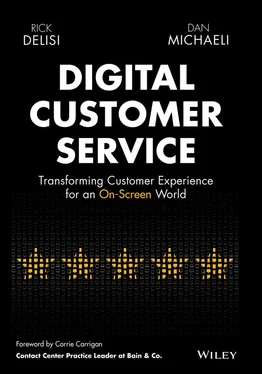To be successful with customers who are now fully immersed in their digital-first lifestyle, companies can no longer “be OK” with service journeys that feel disconnected, disjointed, or out of touch with the way people live in today's world.
Story: “Phone” and “Voice” Aren't the Same Thing
It's the same thing. But it's completely different.
Imagine two conversations between the same two people – in this case, a customer and an agent. In both conversations, they are working together to get something done or solve some problem.
It’s the same two people discussing the same exact issue. But customers were describing these two kinds of conversations as totally different experiences. How could that be?
This is the thought that clicked in my head as I started listening to feedback from customers of the earliest companies to transform their service operations to DCS. These were the people who were among the first to experience OnScreen Enhancements seamlessly woven into their digital journeys.
I was thinking about all the data I've seen in the trade press over the past decade about “the increase in customer resistanceto using the phone.” The assumption has always been that as customers become more digitally self-sufficient, they don't want to have to talk to anyone any more.
For example, it's become conventional wisdom that “ millennials don't EVER talk on the phone – to anyone!” So it makes sense that customer research shows increasing preference for texting over talking.
But here were these customers who were having their first-ever voice interactions with agents in DCS (through OnScreen Voice), and they were scoring 90 percent on CSAT, 15–20 points higher on NPS (and lower for customer effort) across the board. Older people and younger people.
So, if customers don't like talking to an agent, how could THAT be?
What we're learning is: Customers don't, in fact, hate talking . What they hate is feeling forced to have to dial a phone number that is disconnected from their digital experience . Many will do almost anything to avoid having to.
But that can lead to other problems. What about situations that require additional diagnosis, or where a person isn't confident they know what they need or want? Those are handled much more effectively with a live interaction. Or what about situations in which an interaction with an agent could lead to greater long-term revenue for the company?
As we learn more about the psychology of customers who engage in DCS interactions, we're seeing that when a person is already in the midst of trying to do something on a website or app, if they need some help and have a verbal conversation with an agent through their screen – their reaction to that experience is almost 180-degrees different than if they had to give up and then dial a phone number.
The reason: In DCS, if you want to talk, there's no need to start all over. Whether it's an OnScreen Voice conversation or video chat, and especially if there's an opportunity for the customer and agent to be working on the same screen through CoBrowsing – it's still the same two people , taking care of the same issue, but it feels like a completely different experience .
People may not dislike “talking to another human being” as much as we've all been led to believe.
What they really dislike is having to stop what they were doing online, then finding a phone number, calling that number, going through a slew of IVR options (hoping they've picked the right selection) waiting on hold for who-knows-how-long, listening to the same looping soundtrack of elevator music (hoping they won't get disconnected) until an agent finally picks up … and THEN makes them start the process all over again.
Maybe that's the part they hate.
— DM
Let's reflect on of the benefits created by the transformation to a DCS service model – as experienced by each of the stakeholders in this “win-win-win-win” proposition.
WIN #1: THE BENEFITS OF DCS FOR COMPANIES
Greater operational efficiency
Increased online conversion rate
Higher CSAT, NPS, and lower customer effort
In customer service, the battle between costand qualityhas always been assumed to be a zero-sum equation – whatever you give to one side, must be taken from the other.
And in the analog world – the one in which customer service was built on a phone-first platform then got gussied-up with a few digital ornaments just to keep up with the times – at best, most companies attempt to balance the two outcomes. This can feel like an unending struggle.
But if a primary goal for any company is to acquire, retain and grow its customer base, the most significant benefit of a DCS service model is that it creates the ideal loyalty-boosting experience for customers, while also reducing operating costs.
That's like having your cake, eating it too, and losing weight in the process!
The First Hurdle: Calculating the Business Value of Transforming to DCS
No major initiative at any organization is likely to get the “green light” without the promise of a substantial ROI. And, as we will be sharing more stories from the companies that are already operating in a DCS environment throughout the book, we will be offering much of the ammunition you will need to make a compelling business case for digital transformation. But – for starters – here is the basic formula for determining the operational efficiency that can be achieved through this transformation:
Call data/cost. Calculate the total number of minutes all agents are interacting with all customers by phone.
DCS opportunities. Determine the percentage of incoming calls during which the customer is on or near a screen (smartphone, tablet, laptop, desktop). Every one of these interactions has high potential for improvement through DCS. Communication, automation, and collaboration can be introduced right on the customer's screen to make the experience far better (since they are already on the screen!).Suggestion: Ask your agents, “How often are you getting calls to help a customer with something they are struggling to do online? How about something they could do online if you taught them how?”
DCS OnScreen benefits. Calculate the cost savings and efficiency boost of using OnScreen communication, collaboration, and automation to:Decrease the handle time of each interaction.Enable customers to become more digitally self-sufficient, thus reducing their future dependence on live service.
Call data/cost: Imagine a company that receives one million phone calls annually, with an overall AHT (average handle time) of six minutes. That's six million minutes of talk time. Their annual staff budget is $3 million with a cost per minute of $0.50.
DCS opportunities: The percentage of customers who could have resolved their issue in self-service is about 50 percent. The percentage within that group of people who were near a screen at the moment of their call is 80 percent (remember, when a customer is calling from a smartphone they are already on a screen!)
This means about 40 percent of total annual call minutes could be influenced if they were transformed into a DCS experience. That's 2.4 million “influenceable minutes.”
DCS OnScreen benefits: On average, a DCS interaction goes about one-third faster – because the customer and the agent are looking at the same exact thing, and the agent can show the customer where to find things on their own screen.
Читать дальше









